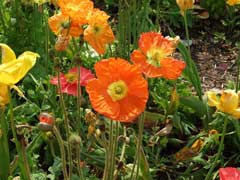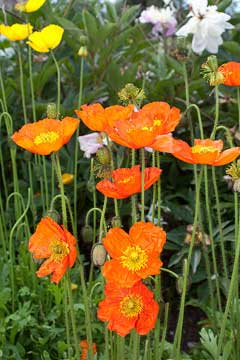 |
|
http://commons.wikimedia.org/wiki/User:Jnn |
 |
| http://commons.wikimedia.org/wiki/User:Maedin |
Translate this page:
Summary
Bloom Color: Orange, Pink, Red, White, Yellow. Main Bloom Time: Early summer, Late summer, Mid summer. Form: Upright or erect.
Physical Characteristics

 Papaver_nudicaule is a PERENNIAL growing to 0.3 m (1ft) by 0.3 m (1ft in) at a medium rate.
Papaver_nudicaule is a PERENNIAL growing to 0.3 m (1ft) by 0.3 m (1ft in) at a medium rate.
See above for USDA hardiness. It is hardy to UK zone 2 and is not frost tender. It is in flower from May to September, and the seeds ripen from June to October. The species is hermaphrodite (has both male and female organs) and is pollinated by Bees. The plant is self-fertile.
Suitable for: light (sandy) and medium (loamy) soils and prefers well-drained soil. Suitable pH: mildly acid, neutral and basic (mildly alkaline) soils. It can grow in semi-shade (light woodland) or no shade. It prefers dry or moist soil.
UK Hardiness Map
US Hardiness Map
Synonyms
Plant Habitats
Edible Uses
Leaves - cooked[2]. Very agreeable to the taste, the leaves are a good source of vitamin C[2]. Some caution is advised, see the notes above on toxicity. Seed - raw or cooked. Oleaginous and antiscorbutic, the seed is very agreeable to the taste[2]. It contains some opium[61]. Caution is advised, see note at top of page.
References More on Edible Uses
Medicinal Uses
Plants For A Future can not take any responsibility for any adverse effects from the use of plants. Always seek advice from a professional before using a plant medicinally.
Anodyne, antiscorbutic[2, 61]. The flowers and seed capsules are mildly diaphoretic[240].
References More on Medicinal Uses
The Bookshop: Edible Plant Books
Our Latest books on Perennial Plants For Food Forests and Permaculture Gardens in paperback or digital formats.

Edible Tropical Plants
Food Forest Plants for Hotter Conditions: 250+ Plants For Tropical Food Forests & Permaculture Gardens.
More

Edible Temperate Plants
Plants for Your Food Forest: 500 Plants for Temperate Food Forests & Permaculture Gardens.
More

More Books
PFAF have eight books available in paperback and digital formats. Browse the shop for more information.
Shop Now
Other Uses
Red and beige dyes are obtained from the flowers[168]. Yellow and brown dyes are obtained from the flower pods[168] (does this mean the immature flower bud or the developing seed head?).
Special Uses
References More on Other Uses
Cultivation details
Landscape Uses:Alpine garden, Container, Foundation, Massing, Rock garden. Prefers a well-drained sandy loam in a sunny position[111, 200]. Prefers a fertile soil[200]. Prefers a deep soil that is poor and dry rather than rich, and strongly dislikes wet conditions[233]. Succeeds in dry soils. Prefers partial shade[188]. There are many named varieties selected for their ornamental value[200]. Members of this genus are rarely if ever troubled by browsing deer or rabbits[233]. A short-lived perennial, it is often grown as an annual or biennial[200]. It often dies out in heavy soils or wet winters[111]. Special Features:
Attractive foliage, North American native, Naturalizing, All or parts of this plant are poisonous, Suitable for cut flowers, Fragrant flowers.
References Carbon Farming Information and Carbon Sequestration Information
Temperature Converter
Type a value in the Celsius field to convert the value to Fahrenheit:
Fahrenheit:
The PFAF Bookshop
Plants For A Future have a number of books available in paperback and digital form. Book titles include Edible Plants, Edible Perennials, Edible Trees,Edible Shrubs, Woodland Gardening, and Temperate Food Forest Plants. Our new book is Food Forest Plants For Hotter Conditions (Tropical and Sub-Tropical).
Shop Now
Plant Propagation
Seed - sow spring in situ[111]. Plants can be transplanted[200]. Division in March or October with care[111]. Larger divisions can be planted out direct into their permanent positions. We have found that it is better to pot up the smaller divisions and grow them on in light shade in a cold frame until they are well established before planting them out in late spring or early summer. Root cuttings 10cm long, November/December in a cold frame.
Other Names
If available other names are mentioned here
Native Plant Search
Search over 900 plants ideal for food forests and permaculture gardens. Filter to search native plants to your area. The plants selected are the plants in our book 'Plants For Your Food Forest: 500 Plants for Temperate Food Forests and Permaculture Gardens, as well as plants chosen for our forthcoming related books for Tropical/Hot Wet Climates and Mediterranean/Hot Dry Climates. Native Plant Search
Found In
Countries where the plant has been found are listed here if the information is available
Weed Potential
Right plant wrong place. We are currently updating this section.
Please note that a plant may be invasive in one area but may not in your area so it’s worth checking.
Conservation Status
IUCN Red List of Threatened Plants Status :

Growth: S = slow M = medium F = fast. Soil: L = light (sandy) M = medium H = heavy (clay). pH: A = acid N = neutral B = basic (alkaline). Shade: F = full shade S = semi-shade N = no shade. Moisture: D = dry M = Moist We = wet Wa = water.

Expert comment
Author
L.
Botanical References
74200270
Links / References
For a list of references used on this page please go here
Readers comment
| Add a comment |
|
If you have important information about this plant that may help other users please add a comment or link below. Only comments or links that are felt to be directly relevant to a plant will be included. If you think a comment/link or information contained on this page is inaccurate or misleading we would welcome your feedback at [email protected]. If you have questions about a plant please use the Forum on this website as we do not have the resources to answer questions ourselves.
* Please note: the comments by website users are not necessarily those held by PFAF and may give misleading or inaccurate information.
To leave a comment please Register or login here All comments need to be approved so will not appear immediately.
|
Subject : Papaver_nudicaule
|
|
|
|